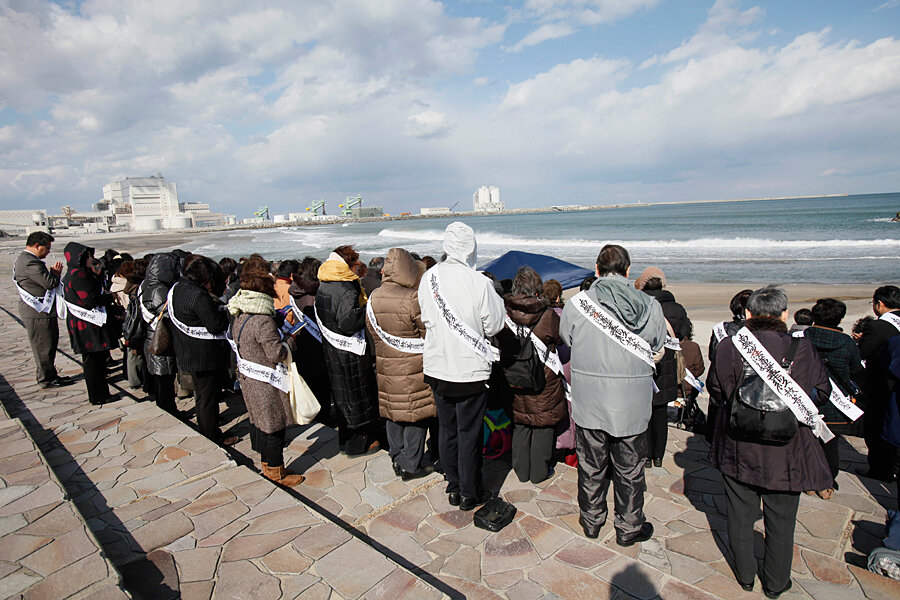Japan's Fukushima recovery: What's been done and what's still to do
Loading...
| Tokyo
At 2:46 pm today, millions of people in Japan paused to observe a moment's silence in honor of the victims of the tsunami that devastated the country's northeast coastline three years ago.
At memorial events held in villages and towns that were washed away by the tsunami, warning sirens sounded in an eerie echo of the tragedy.
In Fukushima, meanwhile, displaced residents marking the anniversary wondered when, or if, they would ever be able to permanently return to homes that were irradiated by the accident at the Fukushima Daiichi nuclear power plant.
For the survivors, the anniversary was a time for private, silent tributes to family, friends, and colleagues among the 15,884 dead and 2,636 missing in the three worst hit prefectures of Fukushima, Miyagi, and Iwate.
But it was also an opportunity to take stock of the progress made since the country wrestled with the worst disaster in its postwar history, triggered by an earthquake so powerful that it knocked the earth off its axis and nudged Japan's main island slightly to the east. Yet tough questions remain over what is widely viewed as a very slow pace of recovery.
Reconstruction delays
Prime Minister Shinzo Abe promised today to speed up the government's five-year, 25 trillion yen reconstruction program.
Speaking to more than 1,000 people at the National Theater in Tokyo, Abe said he had taken "to heart" the lessons of three years ago, and vowed to "create a nation with strong resilience to disasters."
But building that nation is taking longer than might be expected in the world's third-biggest economy.
As of last month, just 1,011 of a planned 29,500 public housing units had been completed in eight prefectures in northeast Japan, according to estimates by the land ministry.
Almost 270,000 people who lost their homes in the tsunami or were forced by radiation to evacuate are still displaced. Almost 100,000 are in temporary housing, according to the reconstruction agency, while the rest have found private accommodation or are staying with relatives. In the immediate aftermath of the earthquake-tsunami-nuclear accident, 470,000 people were displaced.
Reconstruction is being held up by red tape, a labor shortage in the affected region, and disagreement among residents over where to rebuild their communities – near the coast or on higher ground beyond the reach of future tsunami.
The huge disruption caused by the triple disaster is taking its toll on the health of survivors. According to local government data, deaths caused by suicide or the physical and mental stress of life in temporary accommodation stood at more than 3,000 on the eve of the anniversary.
But there are signs of modest progress. In Ishinomaki, where more than 3,000 people died, survivors have started to move into new housing. In Rikuzentakata, where the city center was wiped out by the tsunami, construction of homes in elevated areas away from the coastline is finally under way after years of bureaucratic delays.
Lives on hold
In Fukushima, more than 100,000 people have had to put their lives on hold while the authorities struggle to decontaminate neighborhoods close to the nuclear plant.
Yoshiichi Yanai, however, was dealt a doubly cruel blow. The old Japanese house in the Fukushima town of Naraha that his family had occupied for generations was destroyed by the tsunami, which killed his elder sister, Takako.
Then, just a day after the disaster Mr. Yanai, his younger sister, and their 75-year-old father had to evacuate their temporary shelter following a series of hydrogen explosions at the nearby nuclear plant.
Today, he and his father occupy a modest temporary housing unit near Iwaki, a city about 40 kilometers (about 24 miles) from the facility.
"Stress and boredom are our biggest problems," Yanai says in an interview at his home. "My father and I are both drinking a lot more than we used to, because we've got nothing else to do, and it relieves stress. It's difficult to think of anything that has improved over the past three years."
Yanai's home is one of several areas near the Fukushima plant where decontamination work has reduced radiation enough for the government to consider a partial lifting of the evacuation order in the coming weeks. Initially, residents will be allowed to return during daylight hours, but not stay overnight.
"It would be foolish to move back there while the situation at the nuclear plant is still so volatile," Yanai says, adding that the family had decided to pool their savings and compensation money to build a new home in Iwaki. "Who in their right mind would want to live there?"
Lack of attention
Japanese newspapers and TV networks rolled out extensive coverage of the anniversary, with many focusing on the frustrations of survivors and nuclear refugees who have yet to return home.
But the disaster no longer holds a special place in the national consciousness – an inevitable result, perhaps, of the passage of time. Mishaps at the troubled nuclear plant barely register in the west and south of the country, while people not directly affected by the tsunami assume that reconstruction is progressing as planned.
In a survey of survivors conducted last month by the Asahi Shimbun, 76 percent said they felt that the disaster was fading from the public's memory, while 71 percent complained that reconstruction of the tsunami-hit coastline had made little or no headway.
Wastewater contamination is the key concern
The biggest immediate concern for Fukushima residents is the ongoing battle at the plant to contain daily leaks into the sea and soil of huge quantities of radioactive water. Groundwater flowing in from the hills behind the facility becomes tainted when it mixes with water being used to cool melted fuel in the basements of the damaged reactors.
Possible solutions include the construction of a 2-kilometer-long (about 1 mile) underground ice wall around the reactors or, as some experts have advised the plant operator, Tokyo Electric Power (Tepco), treating the toxic water and then releasing it into the Pacific Ocean – a move opposed by local fishermen and neighboring countries.
Nuclear officials admit that work to decommission the plant, which is expected to take 40 years, won't begin until the wastewater is dealt with.
"The most pressing issue for us is the contaminated water, rather than decommissioning," Akira Ono, the plant's chief, told foreign media organizations, including the Monitor, on Monday. "Unless we address this issue the public will not be assured and the evacuees will not be able to return home."
Those evacuees include Michihito Endo and his wife, Yoko, whose abandoned home in Tomioka, about 11 kilometers (6 miles) south of the plant, is now overrun by vermin. The nuclear accident forced the couple to leave behind an idyllic life of long walks in the countryside and proximity to relatives and friends.
"We had both just retired and were looking forward to the next phase in our lives, and then this happened," says Mr. Endo.
The couple now lives in a modest rented house in Iwaki, and say the have no intention of returning to Tomioka. "Our new place is small, but we are still together and have our health," he adds. "Compared to other people from Fukushima, we are lucky."






